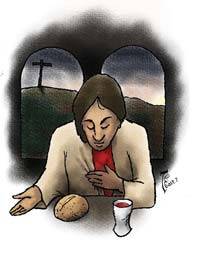Glory and Suffering
In our eucharistic liturgies we regularly say or sing “Glory to God in the highest” and “to God…be all glory.” The motto of the Society of Jesus is Ad majorem Dei gloriam (“For the greater glory of God”), and the Latin phrase soli Deo gloria (“to God alone the glory”) is still used at some celebratory occasions. Today’s readings for the Seventh Sunday of Easter remind us that for Christians, glory and suffering are not opposites but rather may be closely related.
Today’s excerpt from Jesus’ high priestly prayer in John 17 features the words “glory” and “glorify.” In the Old Testament “glory” is used with reference to God’s impact or influence in our world and in our lives. The Hebrew word for glory (kabod) means something substantial, weighty or heavy. It also refers to the brilliance or splendor of God. In the Old Testament, God reveals his glory in the great moments of salvation history: creation, the exodus from Egypt, the giving of the covenant, the dedication of the Jerusalem Temple under Solomon, and so on. The God of the Hebrew Bible makes an impact by manifesting his glory—that is, his weightiness and brilliance. In the New Testament, the Greek word for glory (doxa) conveys the idea of brilliance, splendor and power in appearance. The glory of God is made manifest especially in the person of Jesus—in his incarnation as the Word of God, in his wise teachings and mighty actions and in his passion, death and resurrection.
In the beginning of his prayer at the Last Supper, according to John 17, Jesus asks his heavenly Father to “give glory to your Son, so that your Son may glorify you.” He prays that his “hour”—his passion, death and resurrection—may be seen for what it really is—the hour of his glory. It is not a defeat but a victory, not a source of shame but a source of glory. He also prays that through his hour he may give eternal life to all those whom God has given him.
There is a kind of chain here, a chain of glory extending from the Father to the Son and from the Son to us. This glory is manifested most concretely and surprisingly in the Cross, in the sufferings of Jesus and in his apparently shameful death. While visible only to the eyes of faith, this glory is, according to the Christian Bible, the definitive revelation of the glory of God.
According to Acts 1, the apostles and Jesus’ family have gained through his resurrection and ascension a new perspective on Jesus’ suffering and death. Apparently they too had come to view the hour of Jesus as a manifestation of God’s glory and had gathered in Jerusalem to await the coming of the Holy Spirit upon them at Pentecost. According to Luke, the mother of Jesus was among them, making Mary the one figure present in Jesus’ life from beginning to end and the most faithful disciple of all, despite having her heart pierced with the sword of suffering (Lk 2:35).
The connection between suffering and glory is also prominent in today’s selection from 1 Peter 4. The Christians addressed in that letter had found in the church a new spiritual home and a new identity as God’s people in Christ. Yet they were suffering slanders and social ostracism because of their new way of life. An even more organized persecution may have already begun or at least threatened them.
The passage focuses on the recipients’ sufferings “for the name of Christ.” These Christians’ new values and new ways of acting set them apart from the surrounding society, and they met hostility and anger from some of their neighbors. Peter insists that Christians should not give occasion for suffering by bad behavior. He also contends that suffering for the name of Christ can be an opportunity to glorify God; it can even be a sign of God’s favor. And Peter promises that when the glory of Christ is revealed at the second coming of Christ, those who have suffered for the name of Christ will “rejoice exultantly.” Peter teaches that suffering is part of the Easter experience and can serve to glorify God and prepare us to share in Christ’s own glory. As Jesus glorified his Father in his “hour,” so faithful Christians can and do glorify God as they “share in the sufferings of Christ.”
All these readings point toward the paradoxical conclusion that in the Christian theological vision, glory and suffering are not opposites but rather are closely related and even intertwined.
This article also appeared in print, under the headline “Glory and Suffering,” in the April 28, 2008, issue.








